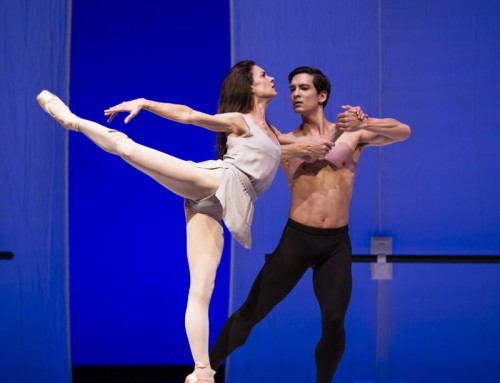PNB: Your company in Montreal is called RUBBERBANDance Group. Where did that name come from?
VQ: Partly an identity of a time back when I was in Los Angeles dancing in ciphers, in underground hip-hop spots. That’s part of it. And then another part of it is the notion of taking many different influences, bundling them up together, and dissolving the boundaries of where one style or genre ends and where the other one begins by stretching those categories out of shape.
PNB: Early on in your career you worked a little with Twyla Tharp. How did that experience working with her and her choreographic process influence you?
VQ: Yeah, I worked for about three years with Twyla Tharp in New York. That’s why I left Los Angeles actually. I was touring with her company.
Obviously she’s a prolific and accomplished dance maker and I am definitely influenced by that experience. I don’t know exactly if I can put it all into words right now. I was very influenced by the time I spent growing as a young dancer in that situation, which was extremely demanding and not a lot of time for messing around. We put the work in and rose to the occasion.
PNB: Yes, when she’s been here working with Company, we’ve all been impressed with her work ethic.
VQ: I didn’t really know what I was getting myself into with someone that is so rigorous and so demanding, but that’s because I didn’t really come up through this classical culture. I started out very young street dancing, that’s another, what do you call it….undisciplined discipline that happens in that world and I think Twyla really helped me. That experience with her really put up a very strong framework around how I approach making work and getting work done.
PNB: While we’re talking a little bit about your process, what is it like working with a classical company versus your own company?
VQ: In a situation like this big company, I think the biggest, most obvious difference for me is the scheduling and how I spend time with people – and what kind of time I spend with them. When it’s my company, that’s what we’re working on. It’s just us, and that’s what we’re focusing on.
I’m also thinking a lot about the space… where it’s going to be presented and the size of the theater. That’s something that keeps popping up in my mind, as opposed to when I’m making work for my company, which is not necessarily performed in opera houses. Most of the time, it’s more intimate one thousand seat houses, and a thousand seats versus three thousand seats is a huge difference when considering how close the audience is and what can happen.
The dancers here are phenomenal and it’s great to have a huge group, like an endless number of dancers here that can follow me giving them a lot of information in just a few weeks. I’m interested in getting their bodies out of what their normal habits are and exploring a horizontal or a skewed axis, not necessarily staying up on the longest vertical line. I think that’s the big shift for everyone here, but I’m lucky and appreciative to be able to work with dancers who have a more classical sensibility.
PNB: And how has [Stager Anne Plamondon] helped out in that process?
VQ: Oh, Anne’s great because she’s been working with me for almost ten years and so the technique that is supporting the movement that I’m asking the dancers to do, she was part of the creation of that technique. Even if it’s brand new movement, she’ll know how to help the dancers work toward getting out of that verticality, finding out how to connect in the way that we’re connecting – the partnering that we’re doing is quite different– there are subtle differences that make it unique in the way that we connect with partners. So having her there as a woman, connecting with the woman’s body then helping the women –the women sometimes see me and they’re like, oh well he’s a guy, and so yeah, he’s moving that way, but to see a woman that can really help them find their pathway into this way of moving is super.
PNB: Got it. So, what do you like to do when you’re here in Seattle? You’ve been here before…
VQ: Well, it’s a beautiful, beautiful, beautiful. Last weekend was a great weekend. When we’re working, 7PM comes and you’re so busted (laughs) but this weekend, we walked a lot, and went to the market and down to the waterfront. I just think Seattle is great, the people are great, everything is beautiful and I’m just happy we’re having so much fun.
Pacific Northwest Ballet presents NEW WORKS
March 16-24, 2012 at McCaw Hall
Featured photo: Victor Quijada working with Company dancers. Photo by Lindsay Thomas.
Click here for images of Victor working with PNB Dancers.





